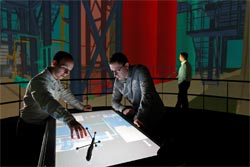Virtual plant planning, retrofitting and maintenance

Design review on the planning model of BASF’s factory in the Elbe Dom of the Fraunhofer IFF Virtual Development and Training Centre VDTC. The giant 360 degree projection facilitates in-depth discussion of all of the plant’s details. © Dirk Mahler<br>
With over 110 000 employees, BASF is the world’s largest chemical company. At its headquarters in Ludwigshafen, the company runs over 160 production facilities, two steam crackers, two gas and steam turbine power plants and one sewage treatment plant.
Virtual technologies are helping make information and data on every plant on the premises available digitally to planning engineers, process engineers, assembly coordinators, safety experts and asset managers. A virtual copy of a plant displays every possible view, whether in graphics or figures, in drawings or simulations. This expedites and improves the planning and implementation of new plants or additions and retrofits.
Design reviews are an integral part of the planning process – a virtual model for design reviews realistically reproduces every component with the information related to it. The spatial representation makes hidden components or components aligned behind one another easily viewable. “We reviewed the design of a process plant retrofit together with BASF experts,” reports Sabine Szyler, virtual reality specialist at the Fraunhofer Institute for Factory Operation and Automation IFF. “The space in the plant can be determined far more easily. What sounds so obvious is really a giant leap in perception.”
360 degree projection virtually identical to the original
The design was reviewed in the Elbe Dom of the Fraunhofer IFF’s Virtual Development and Training Centre VDTC in Magdeburg. “After all, the six-meter high, 360 degree projection surface projects a level of a plant, which is virtually identical to the original. This gives viewers the sensation of standing directly in the plant,” explains the researcher. The three-dimensional data from BASF’s planning tools, including the meta data of the plant’s individual components, were exported into the Fraunhofer IFF-researchers’ special virtual reality software – the Virtual Development and Training-Platform.
This enabled plant operators, plant planners and their colleagues, such as piping contractors, equipment and instrument engineers, steel building contractors or safety supervisors, to view details of the plant faithfully reproduced at full scale in the virtual model and clarify many questions such as whether all of the operating elements are easily accessible or all the safety valves are easily operated during an inspection “we are so impressed by the design review with virtual reality that we have set up two VR stations in Ludwigshafen. That enables our planning teams there to review designs of other plants any time,” says Axel Franke, Senior Engineering Manager at BASF.
A retrofit plant performs differently than before and, in the worst case, incorrect operation could bring all plant operation to a complete standstill. Continuous safety training is therefore a top priority in chemical plant engineering. A virtual interactive learning environment is already being used for training in Ludwigshafen. Fraunhofer experts designed a scenario for the retrofit of a nitric acid plant, which enabled the team of operators to inspect and get acquainted with the plant already before its commissioning. The Fraunhofer experts set up a mobile VR training station directly in the control room. The training module presents the complete 3-D model of the plant. All of the meta data such as serial numbers, temperatures, pressures and media as well as training materials can be viewed. Workers were able to familiarize themselves with its new operation, identify new access points and learn new safety regulations.
The experts from BASF and the Fraunhofer IFF concur that plant engineers will be unable to operate internationally in the future without virtual technologies. BASF is working on intensifying its use of virtual technologies in the future in order to maintain its leadership among chemical plant operators. The Fraunhofer IFF will continue providing conceptual support.
Media Contact
All latest news from the category: Process Engineering
This special field revolves around processes for modifying material properties (milling, cooling), composition (filtration, distillation) and type (oxidation, hydration).
Valuable information is available on a broad range of technologies including material separation, laser processes, measuring techniques and robot engineering in addition to testing methods and coating and materials analysis processes.
Newest articles

NASA: Mystery of life’s handedness deepens
The mystery of why life uses molecules with specific orientations has deepened with a NASA-funded discovery that RNA — a key molecule thought to have potentially held the instructions for…

What are the effects of historic lithium mining on water quality?
Study reveals low levels of common contaminants but high levels of other elements in waters associated with an abandoned lithium mine. Lithium ore and mining waste from a historic lithium…

Quantum-inspired design boosts efficiency of heat-to-electricity conversion
Rice engineers take unconventional route to improving thermophotovoltaic systems. Researchers at Rice University have found a new way to improve a key element of thermophotovoltaic (TPV) systems, which convert heat…



